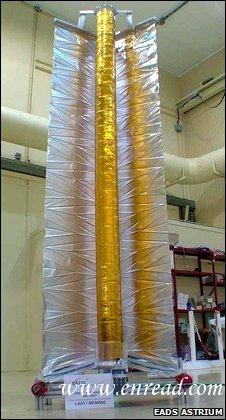| ||||||||||||||||||||||||||||||||||||||||||||||||||||||||||||||||||||||||||||||||||||||||||||||||||||||||||||||||||||||||||||||||||||||||||||||||||||||||||||||||
|
Satellites and spent rocket stages could soon deploy1 "sails" to guide them back to Earth much faster than they would otherwise fall out of the sky. 卫星和运载火箭很快就可以通过引导更快地回收回地球。 The booms can be inflated2 with gas but need then to be made rigid3 With space becoming ever more crowded, there is a need to remove redundant4 objects that could pose a collision(碰撞,冲击) threat to operational missions. Extending a sail on an old spacecraft would increase drag and pull it into the Earth's atmosphere to burn up. Major European space firm EADS Astrium says the scheme has great potential. "It is an interesting solution, especially for the satellite that has no propulsion system at the end of its life," Brice Santerre told BBC News. Santerre and colleague Max Cerf have been working on what they call the Innovative5 DEorbiting Aerobrake System (IDEAS). The concept involves extending booms and sheeting from spacecraft to increase the amount of drag they experience from the residual6(残余空气) air molecules7 still present at altitudes(高度,海拔) up to even 750km (470 miles) "The principle of aerobraking(航空刹车装置) is to increase the surface over mass ratio(质量比) of an orbital object, to accelerate the fall-out by increasing the drag on the system," Mr Santerre said. "To do that, we need to deploy a very light structure. That's why we chose to use 'gossamer8(薄弱的) structures'. These are composed of booms and very thin membranes9." Santerre and Serf have been developing an aerobraking sail concept for the forthcoming French Microscope satellite. Microscope is a science mission that will investigate the force of gravity and the behaviour of free-falling objects in a test of what has become known as the equivalence principle(等效性原理). The satellite will take about a year to make its measurements and will then have no further purpose. Ideally, such a spacecraft would be removed from orbit, especially since it will be circling at an altitude where many important Earth observation satellites also operate. "Microscope has no propulsion(推动系统,动力装置) system so it cannot de-orbit by itself. If we were to do nothing, the fall-out duration(持续,持久) would be between 50 and 100 years," said Mr Santerre. By erecting11(竖立) their boom and membrane10 mechanism12, Santerre and Serf believe Microscope could be brought out of the sky in less than 25 years, which meets international orbital junk mitigation(缓和,减轻) guidelines(指导方针). Astrium is now investigating how the IDEAS concept could be applied13 to spent rocket stages. The company leads the production of Europe's premier14 launcher, the Ariane 5. Much of the Ariane's structure - its main core stage and solid boosters - fall rapidly out of the sky at the end of a flight; but the upper-stage is much longer lived in orbit. Once it has ejected its satellite payload(有效负载), the stage continues to circle the Earth in a large ellipse(椭圆), running out to more than 35,000km from the Earth and coming as close as about 250km. It may take 100 years before an upper-stage falls naturally from the sky. "Our study shows that if we want to apply the aerobraking concept to an Ariane-class upper-stage then we need a system with booms, or masts, of about 12m and a deployed15 surface of about 250 sq m. "This is possible with our current technologies. We need now to check that this is the best solution. We are also thinking whether this type of system can be applied to other launchers as well." One alternative, of course, is to give the Ariane 5 upper-stage the capability16 to take a powered dive into the Earth's atmosphere. This was done for the first time last year at the end of the launch of the Jules Verne space station freighter. This was considered essential because of the number of manned missions that routinely follow station's orbit. Once Jules Verne was released from the rocket, the upper-stage reignited(再点火,再点燃) its engine to make a controlled burn-up over the Pacific. The advantages of de-orbiting in this way are clear, but the extra fuel requirements and complexity17 of re-ignitable(可燃的) engines adds cost to what is already a very expensive endeavour(奋力号). Aerobraking sails, on the other hand, are lightweight and extremely simple. Their operation could even be controlled by a pre-set timer, fixed18 to deploy a certain number of minutes after the end of a flight. This means that even an upper-stage that is out of control can still be guaranteed to return to Earth in a timely fashion. Santerre and Serf presented their latest research at the recent European Conference on Space Debris19 in Darmstadt, Germany. The meeting closed with a statement from its organisers saying that effective measures to clean up space debris needed to be devised and implemented20(应用的). 点击  收听单词发音 收听单词发音
|
||||||||||||||||||||||||||||||||||||||||||||||||||||||||||||||||||||||||||||||||||||||||||||||||||||||||||||||||||||||||||||||||||||||||||||||||||||||||||||||||
- 发表评论
-
- 最新评论 进入详细评论页>>




